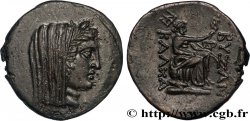bgr_353389 - THRACE - BYZANTION Tétradrachme
Not available.
Item sold on our e-shop (2015)
Price : 2 800.00 €
Item sold on our e-shop (2015)
Price : 2 800.00 €
Type : Tétradrachme
Date: c. 220-219 AC.
Mint name / Town : Byzance, Thrace
Metal : silver
Diameter : 27,5 mm
Orientation dies : 12 h.
Weight : 13,77 g.
Rarity : R3
Coments on the condition:
Exemplaire sur un flan ovale, bien centré des deux côtés avec une petit manque de métal à 9 heures au droit. Belle tête de Déméter au droit. Revers finement détaillé, de frappe un peu molle. Patine grise superficielle avec des reflets dorés avec un argent légèrement corné
Catalogue references :
Predigree :
Cet exemplaire provient de la vente CNG, 75, n° 100 et de la collection B. Odaert
Obverse
Obverse legend : ANÉPIGRAPHE.
Obverse description : Tête voilée de Déméter à droite, coiffée d’une couronne d’épis.
Reverse
Reverse description : Poséidon nu jusqu’à la ceinture assis à droite sur un rocher, tenant un aplustre de la main droite tendue et un trident transversal de la main gauche.
Reverse legend : EPI AQENAIWN/ (KK) - (UP).
Reverse translation : (du magistrat Athénaion/ Byzance).
Commentary
Semble de mêmes coins que l’exemplaire de la vente Hirsch 275, n° 3381.








 Report a mistake
Report a mistake Print the page
Print the page Share my selection
Share my selection Ask a question
Ask a question Consign / sell
Consign / sell
 Full data
Full data